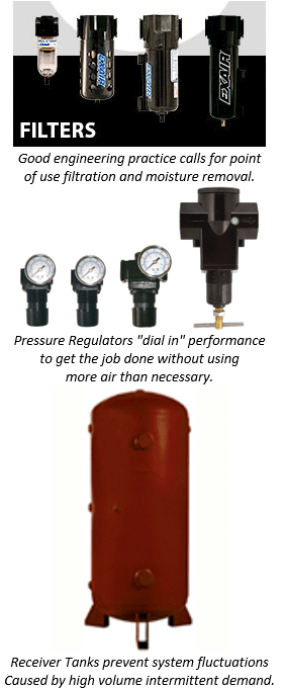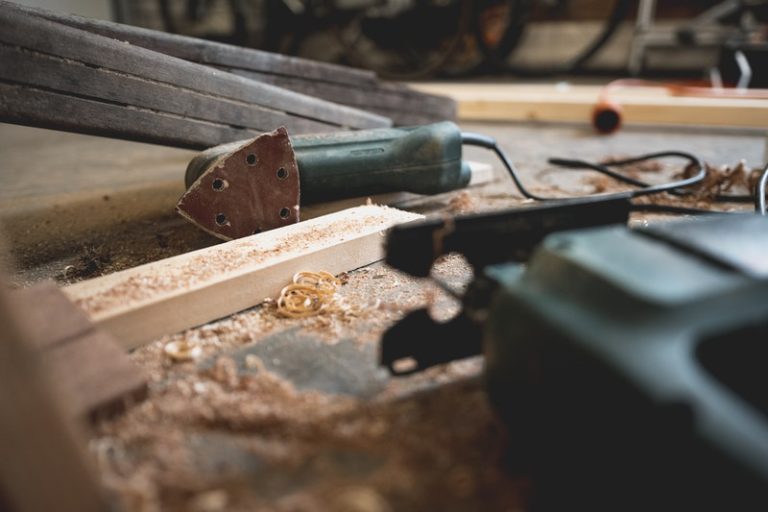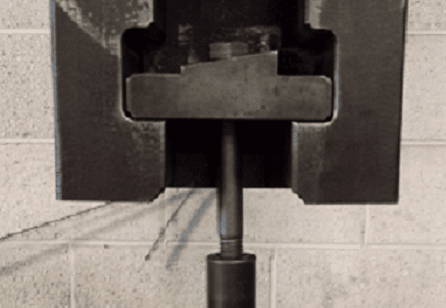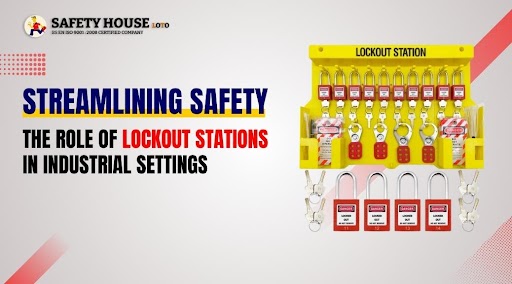Compressed Air System Equipment – What You Need To Know
The use of compressed air in industry is so widespread that it’s long been called “the fourth utility” (along with electricity, water, and natural gas). As a function of energy consumption (running an air compressor) to energy generated (operation of pneumatic equipment), only 10-15% of the energy consumed is converted to usable energy stored as compressed air. Its “bang for the buck”, however, comes when you consider the total cost of ownership – yes, it costs a lot to generate, but:
- It’s relatively safe, when compared to the risks of electrocution, combustion, and explosion associated with electricity & natural gas.
- Air operated tools, equipment, and products are generally much cheaper than their electric, gas, or hydraulic powered counterparts.
- Air operated products, like anything, require periodic maintenance, but oftentimes, that maintenance simply comes down to keeping the air supply clean and moisture free, unlike the extensive (and expensive) maintenance requirements of other industrial machinery.
Even with these advantages, though, it’s still critical to get all you can out of that 10-15% of the energy you’re consuming to make that compressed air, and that starts with having the right stuff in the right place. Now, all of the following “stuff” might not apply to every compressed air system. I once worked in a repair shop, for example, with a small compressor that was used for a couple of blow off guns, impact drivers, and a sidearm grinder. I’ve also done field service in facilities with hundreds of pneumatic cylinders & air motors that operated their machinery. Those places had even more “stuff” than I’m devoting space to in this blog, but here’s a list of the “usual suspects” that you’ll encounter in a properly designed compressed air system:
- Air compressor. I mean, of course you need a compressor, but the size and type will be determined by how you’re going to use your air. The small repair shop I worked in had a 5HP reciprocating positive displacement compressor with a 50 gallon tank, and that was fine. The larger facilities I visited often had several 100 + HP dynamic centrifugal or axial compressors, which get more efficient with size.
- Air preparation. This includes a number of components that can be used to cool, clean, and dry the air your compressor is generating:
- Pressurizing a gas raises its temperature as well. Hot compressed air could cause unsafe surface temperatures and can damage gaskets, seals, and other components in the system. Smaller compressors might not have this problem, as the heat of compression is often dissipated through the wall of the receiver tank and the piping at a rate sufficient to keep the relatively low (and often intermittent) flow at a reasonable temperature. Larger compressors usually come with an aftercooler.
- The air you compress likely has a certain amount of moisture in it…after nitrogen and oxygen, water vapor usually makes up more of the content of atmospheric air than all other trace gases combined. There are a number of air dryer types; selection will be dictated by the specifics of your facility.
- Your air is going to have other contaminants in it too. We did welding & grinding in the repair shop where our compressor sat in the corner. We kept a few spare intake filters handy, and replaced them regularly. In conjunction with the aftercooler & dryer, larger industrial compressors will also have particulate filters for these solids. For extra protection, coalescing filters for oil vapor, and adsorption filters for other gases & liquid vapors, are specified.
- Distribution. In the repair shop, we had a 3/4″ black iron pipe that ran across the ceiling, with a few tees & piping that brought the air down to the individual stations where we used it. The larger facilities I visited had larger variations of this “trunk and branch” type network, and some were even big enough to make use of a loop layout…these were especially popular when multiple air compressors were located throughout the facility. In addition to black iron, copper & aluminum pipe (but NEVER PVC) are commonly used too.
- Condensate removal. The small repair shop compressor had a valve on the bottom of the tank with a small hose that we’d blow down into a plastic jug periodically. Larger systems will have more complex, and oftentimes automated condensate management systems.
So, that’s the system-wide “stuff” you’ll usually encounter in a properly designed compressed air system. After that, we’ll find a number of point-of-use components:

- Air preparation, part 2. The compressor intake & discharge filtration mentioned above make sure that you’re putting clean air in the distribution piping. That’s fine if your distribution piping is corrosion resistant, like aluminum or copper, but black iron WILL corrode, and that’s why you need point-of-use filters. EXAIR Automatic Drain Filter Separators have 5 micron particulate elements, and centrifugal elements that ‘spin’ any moisture out. If oil is an issue, our Oil Removal Filters have coalescing elements for oil/oil vapor removal, and they provide additional particulate protection to 0.03 microns.
- Pressure control. Your compressor’s discharge pressure needs to be high enough to operate your pneumatic device(s) with the highest pressure demand. Odds are, though, that not everything in your plant needs to be operated at that pressure. EXAIR Pressure Regulators are a quick & easy way to ‘dial in’ the precise supply pressure needed for specific products so they can get the job done, without wasting compressed air.
- Storage. This could also be considered system “stuff”, but I’m including it under point-of-use because that’s oftentimes the reason for intermediate storage. Having a ready supply of compressed air near an intermittent and/or large consumption device can ensure proper operation of that device, as well as others in the system that might be “robbed” when that device is actuated. They’re good for the system, too, as they can eliminate the need for higher header pressures, which cause higher operating costs, and increased potential for leaks. EXAIR Model 9500-60 60 Gallon Receiver Tanks are an ideal solution for these situations.
For more information on proper installation and use of compressed air system “stuff” like this, the Compressed Air & Gas Institute’s Compressed Air and Gas Handbook has a good deal of detailed information. The Air Data section of EXAIR’s own Knowledge Base is a great resource as well.
Of course, all the attention you can pay to efficiency on the supply side doesn’t matter near as much if you’re not paying attention to HOW you’re using your compressed air. EXAIR Intelligent Compressed Air Products are designed with efficiency, safety, and noise reduction in mind. Among the other ways my fellow Application Engineers and I can help you get the most out of your compressed air system, we’re also here to make sure you get the right products for your job. To find out more, give me a call.
Russ Bowman, CCASS

Application Engineer
EXAIR Corporation
Visit us on the Web
Follow me on Twitter
Like us on Facebook



![[Infographic] How to Identify the Best Rivet Guns for Your Application](https://twrench.top/wp-content/uploads/2024/01/20240109073802-659cf7da02a56-768x3091.jpg)